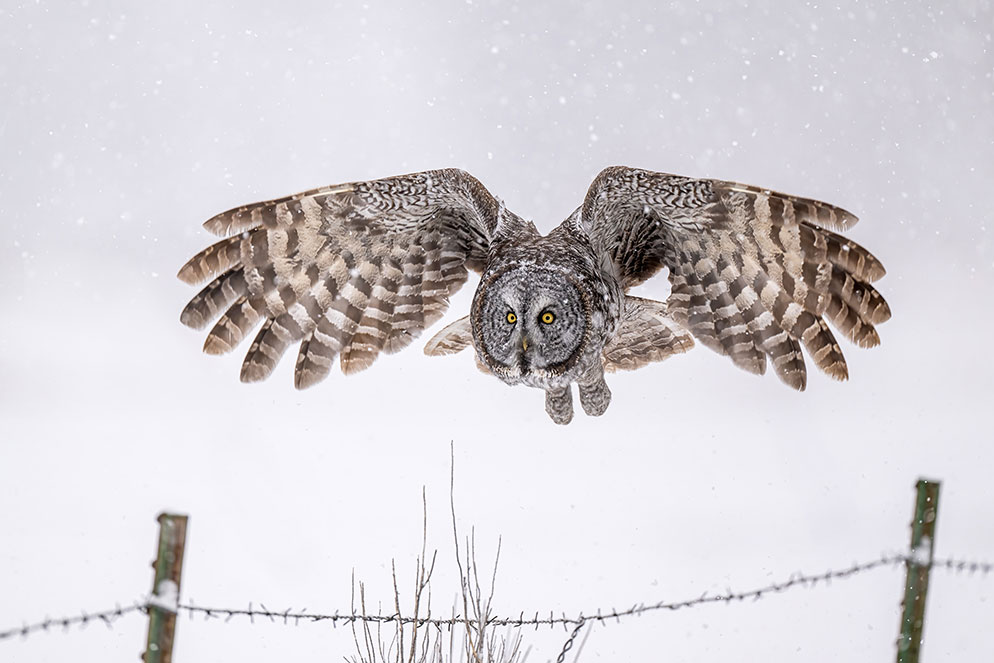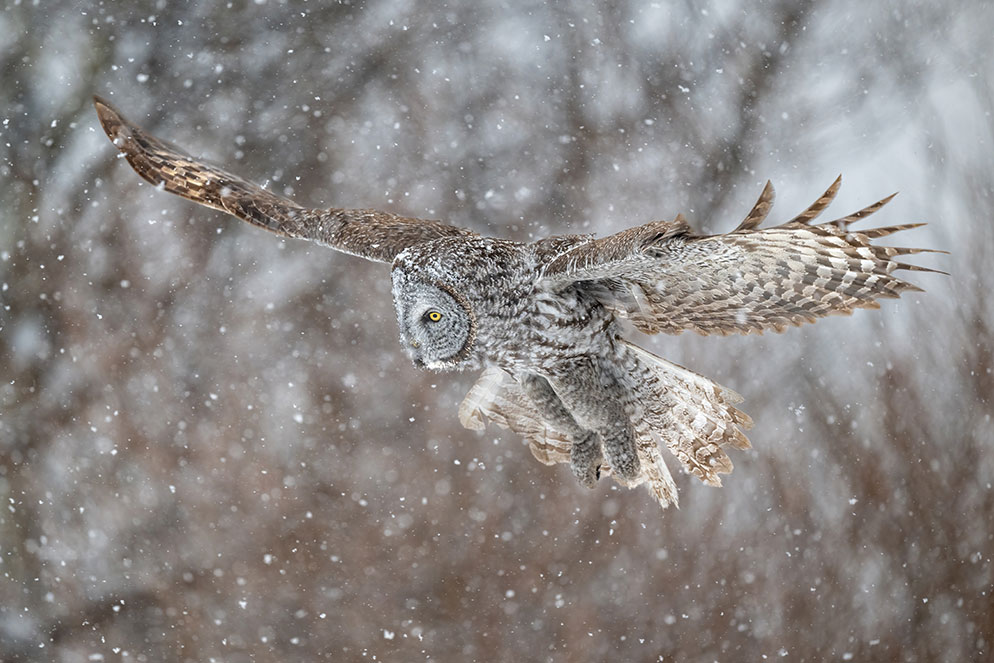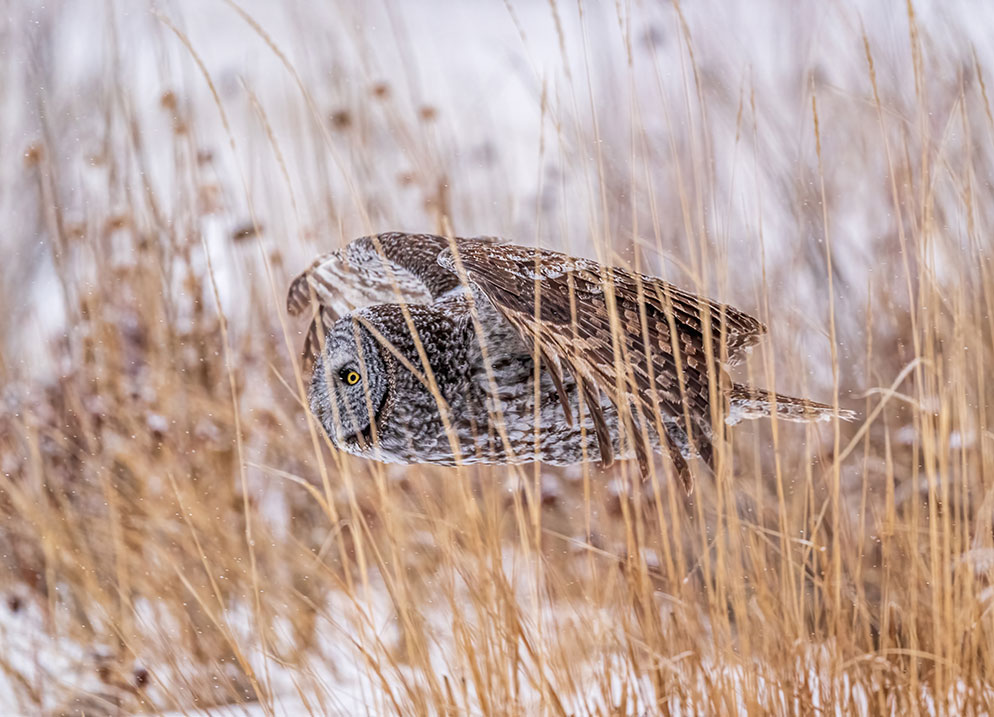Photographing the Great Gray Ghost
Pushing the boundaries of the NIKKOR Z 600mm f/4 TC VR lens
With the camera set to animal eye-detection AF and Wide Area (Large) focus mode, at 20 FPS, every frame of the great grey owl flying past was tack sharp. Z 9, NIKKOR Z 600mm f/4 TC VR, 1/3200 second, f/4, ISO 360, manual exposure, Matrix metering.
In the last few years bird photography has really grown in popularity. I teach a lot of photo workshops, and I get weekly questions about bird photography. What autofocus mode should I use? What is the best wing position in flight? I became obsessed with birds at an early age and photographing them was challenging. But capturing a diving Osprey in flight with every feather tack sharp was incredibly rewarding. As I photographed more and more species, I became really interested in raptors, especially owls. And for me one owl ruled the roost, the great gray owl.
Great gray owls are the largest owls in North America and have the longest body length in the world. They can be over 30 inches long, and have wingspans close to five feet in length. Great gray owls are found in the northern forests of Europe, the United States, Canada, and Alaska. But just because you’re in the owl’s range doesn’t mean you’ll see one. These owls are known as the great gray ghost, or phantom of the north, for a reason. They are very elusive.
A while ago, I got my new NIKKOR Z 600mm f/4 TC VR lens and can say I was very impressed. The fast autofocus, built-in 1.4x Teleconverter, and lightweight design is perfect for bird photography. I decided to really put the 600mm and Z 9 to the test. How would this lens perform in blowing snow and subzero temperatures? I loaded up my truck and headed north into snowy Wyoming and Idaho in search of the great gray ghost.
Using animal eye-detection AF and Wide Area (Large) focus mode, and 20 FPS continuous shooting, the camera and lens combination had no trouble focusing on the owl’s eye and not the snowflakes. Z 9, NIKKOR Z 600mm f/4 TC VR, 1/3200 second, f/4, ISO 720, manual exposure, Matrix metering.
Finding these owls is tricky. I’d spent many days in Wyoming and Idaho locating meadows the owls prefer. The owls are daytime hunters, most active at dawn and dusk. The frustrating part was never really knowing if the owls would show up or not. I would go days and not see an owl, and then suddenly one day they would appear. Would they be there this winter? Driving icy Wyoming roads in subzero temps made me rethink the wisdom of this shoot.
My second morning searching for great gray owls turned out to be one of the best days of owl photography I’ve ever had. I woke to a winter storm warning and blowing snow outside. I decided to walk along a country road that had lots of open meadows, perfect habitat for great gray owls. Ten steps from my truck I found an owl hunting along a fence line; I couldn’t believe my luck. I stopped cold in my tracks, but quickly realized the owl wasn’t disturbed by my presence. He was hunting along the fence line, sometimes landing only 30 feet away. The owl would perch for a few minutes, then take off flying near the ground, searching for mice in the grass.
I quickly set up my Z 9 with the 600mm lens in the falling snow and focused on the owl using animal eye-detect with Wide Area (Large) focus mode. I set my Z 9 to 20 frames-per-second continuous shooting. Blowing snow and blizzards challenge camera autofocus systems. Falling snow confuses cameras and the autofocus will rack back and forth trying to lock onto falling snowflakes, not your subject.
But that wasn’t the case with the Z 9 and NIKKOR Z 600mm f/4 TC VR.
Great gray owl flying through tall grass in blowing snow, and the autofocus locks right onto the bird's eye. Z 9, NIKKOR Z 600mm f/4 TC VR, 1/2500 second, f/4, ISO 2500, manual exposure, Matrix metering.
Even in blowing snow, the combination of the Z 9 and 600mm lens focused right on the owl’s eyes as it flew through the snow. What I really noticed was how fast the lens focused, and how accurate the focus point locked onto the owl’s eye. I normally use the focus limiter switch to speed up autofocus on my long telephoto lenses, but the autofocus was so fast using the new Silky Swift Voice Coil Motor I didn’t even use it. I was shooting at 20 frames per second as the owl flew past, and frame after frame was tack sharp.
At one point the great gray owl flew through tall grass in blowing snow, an almost impossible scenario for any autofocus system to track. But the Z 9 and lens locked onto the owl and the eye was tack sharp between the blades of grass. I’ve never seen autofocus this good. As the owl moved further away, I just flipped on the built-in 1.4x Teleconverter, giving me a focal length of 840mm at f/5.6 lens. There is no way I’d have attempted to put on a separate Teleconverter in these snowy conditions.
The weather was getting worse, and the snow was falling harder. At one point my lens hood had two inches of snow piled inside. The lens was getting thoroughly soaked but was working flawlessly. At another point I fell into a ditch alongside the road and launched my camera and lens into the snow. I just picked it up, brushed the snow off, and kept shooting. It’s not all glory photographing wildlife!
After a week of shooting in extreme conditions with the new NIKKOR Z 600mm f/4 TC VR lens, I couldn’t be happier. This new lens is a game changer for me. It’s like having two lenses, a 600mm f/4 and 840mm f/5.6, with lightning fast, accurate autofocus. Combined with the Z 9’s incredible autofocus, my keeper ratio of wildlife images has greatly improved.
I’m still buzzing about that magical snowy encounter with the great gray owl. Later in the week the owl completely disappeared. Did he fly back north? Maybe he found better hunting meadows? I don’t know when I’ll run into the great gray ghost again, but when I do, I’ll be ready.






